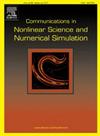On the number of normalized solutions for a fractional Schrödinger problem with logarithmic nonlinearity
IF 3.8
2区 数学
Q1 MATHEMATICS, APPLIED
Communications in Nonlinear Science and Numerical Simulation
Pub Date : 2025-01-20
DOI:10.1016/j.cnsns.2025.108618
引用次数: 0
Abstract
In this paper, we investigate the multiplicity and concentration of normalized solutions to a fractional logarithmic Schrödinger problem with the prescribed mass , where , is unknown and appears as a Lagrange multiplier. By the minimization method combined with penalization technique and Ljusternik–Schnirelmann theory, we prove the multiplicity of normalized solutions where the numbers of normalized solutions are linked to the topology of the set where potential attains its minimum. Moreover, the concentration and decay of normalized solutions are analyzed in the end. The above properties of our normalized solutions are also new, even for .
具有对数非线性的分数阶Schrödinger问题的归一化解的个数
本文研究了一类分数对数Schrödinger问题的归一化解的多重性和集中性,该问题具有规定质量∫RN|u|2dx=a æ Nwitha>0,其中λ∈R是未知的,表现为拉格朗日乘子。通过结合惩罚技术和Ljusternik-Schnirelmann理论的最小化方法,证明了归一化解的数目与势V达到其最小值的集合拓扑相关联的归一化解的多重性。最后分析了归一化溶液的浓度和衰减。上述归一化解的性质也是新的,即使对于s=1也是如此。
本文章由计算机程序翻译,如有差异,请以英文原文为准。
求助全文
约1分钟内获得全文
求助全文
来源期刊

Communications in Nonlinear Science and Numerical Simulation
MATHEMATICS, APPLIED-MATHEMATICS, INTERDISCIPLINARY APPLICATIONS
CiteScore
6.80
自引率
7.70%
发文量
378
审稿时长
78 days
期刊介绍:
The journal publishes original research findings on experimental observation, mathematical modeling, theoretical analysis and numerical simulation, for more accurate description, better prediction or novel application, of nonlinear phenomena in science and engineering. It offers a venue for researchers to make rapid exchange of ideas and techniques in nonlinear science and complexity.
The submission of manuscripts with cross-disciplinary approaches in nonlinear science and complexity is particularly encouraged.
Topics of interest:
Nonlinear differential or delay equations, Lie group analysis and asymptotic methods, Discontinuous systems, Fractals, Fractional calculus and dynamics, Nonlinear effects in quantum mechanics, Nonlinear stochastic processes, Experimental nonlinear science, Time-series and signal analysis, Computational methods and simulations in nonlinear science and engineering, Control of dynamical systems, Synchronization, Lyapunov analysis, High-dimensional chaos and turbulence, Chaos in Hamiltonian systems, Integrable systems and solitons, Collective behavior in many-body systems, Biological physics and networks, Nonlinear mechanical systems, Complex systems and complexity.
No length limitation for contributions is set, but only concisely written manuscripts are published. Brief papers are published on the basis of Rapid Communications. Discussions of previously published papers are welcome.
 求助内容:
求助内容: 应助结果提醒方式:
应助结果提醒方式:


